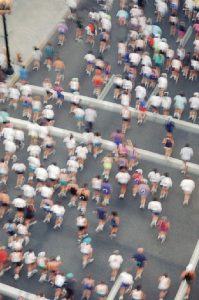 Ironman Louisville takes place this weekend and competitors from all over the world will be present to participate. The Ironman Louisville is a qualifier for the Kona Ironman World Championship held on the Big Island of Hawaii every year.
Ironman Louisville takes place this weekend and competitors from all over the world will be present to participate. The Ironman Louisville is a qualifier for the Kona Ironman World Championship held on the Big Island of Hawaii every year.
The Kona Ironman World Championship race started in 1978 on the island of Oahu with only 15 participants (12 finishers) . The distance of the ironman were set at that race with a 2.4 ocean swim, 112 mile bike ride and a 26.2 mile run. These distances were determined by combining the Waikiki Rough Water Swim, Around Oahu bike race and the Honolulu Marathon move to one continuous race. The event is now held in the lava fields of the Big Island of Hawaii and has over 2000 participants. It is estimated that over 600,000 people have completed an ironman distance.
An excellent article published in Orthopedics Today in July 2017 interviewed a group of orthopedic surgeons that have competed in the Ironman. The group of orthopedic surgeons were asked a series of medical questions.
- What conditions prevent optimal run performance during the Ironman event? – Dr. Miller states that a key to an optimal run segment of the Ironman is hydration and caloric intake on the bike portion of the race. Riders who start the run dehydrated are in for a long day because 2% total body fluid loss has been demonstrated to affect performance and athletes who are slower in the run and gain weight are at risk for hyponatremia. According to Dr. Miller, this is potentially devastating. Athletes should have a clear and objective understanding of their own fluid needs under all race conditions.
- What are the current nutritional recommendations preceding and during the the Ironman? We have heard about carbohydrate loading, but have things changed? – Dr. Sallis states that the key ingredients to a successful ironman are fluids and carbohydrates. The average endurance athlete burns about 80 grams of carbs per hour and loses about 1 gram of sodium in the sweat with an average sweat of 1 liter per hour, but can vary widely. This is why it is critical that athletes in training for the Ironman understand their fluid and carbo needs in all types of weather conditions. A combination of water, sports drinks, energy bars, gels and salt tablets. simply drinking one liter of a sports drink per hour may be right for some athletes but not for others.
- How do you correctly replace sweat loss? It is most important to replace sweat loss. To do this correctly an accurate assessment of sweat rate should be figured out by the athlete. This is completed by measuring the nude weight before and after a 1 hour run and bike done at race pace and in environmental conditions similar to what they will be racing in. The difference between in pre-race and post race workout rate is a good estimate of the athletes hourly sweat plus. For every pound of sweat loss, the Ironman athlete must replace 16 oz of fluid. It is critical for the endurance athlete to match fluid intake with sweat loss to avoid dehydration which can affect performance and health .
- Should an ironman athlete avoid carbs leading up to the race and eat a lot the night before? It is wrong to avoid carbs leading up to the race and then to load the night before. The proper nutrition is to start the race fueled by a high carb meal consumed 3 to 4 hours prior to the race. It is important to start hydrated but not over hydrated. It is imperative they know their sweat rate and drink on a schedule they establish during training runs and rides, such as every 15 minutes
- What are the most common conditions treated in the Ironman medical tent? Dr. Thomas Miller who completed the race in 1996 and now works in the medical tent for ironman races states that up to 1/3 of the competitors will be seen and assessed in the medical tent. Common issues include the following: conditions related to electrolyte disturbances, GI issues such as nausea, vomiting and diarrhea along with cramping, blisters, road rash and fractures. The most life-threatening condition also treated in the medical tent is hyponatremia. Hyponatremia is caused by over drinking of hypotonic fluids such as water and some sports drinks. The symptoms include headache, weight gain, disorientation, flat affect and swelling in the hands and feet. The athletes are weighed before the race and then if they enter the medical tent so there is objective data to assess weight gain. Heat stroke is even more deadly when the diagnosis is missed and treatment is delayed. Classic symptoms are confusion or mental status changes and rectal temperature of greater than 104 F. The athletes may or may not be sweating profusely, or hot to the touch. Dr. Robert Sallis stated the key to the life saving treatment is rapid cooling of the athlete which is done in an ice bath placing the athlete in ice water up to their neck.
- What are the most common orthopedic conditions seen at the Ironman? Dr William Douglas Hiller, three-time Kona Ironman World Champion finisher: 1982, 1983, 1984, stated that fractures bumps and bruises along with joint dislocation, are commonly seen primary from the cycling portion of the race.
Check out this website for more information about Ironman Louisville including a race course overview so you can go out and cheer on the triathletes.

Recent Comments